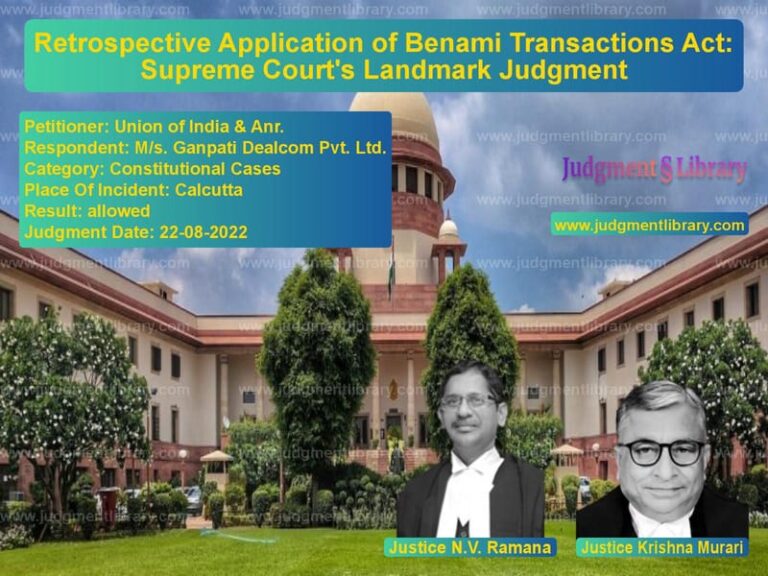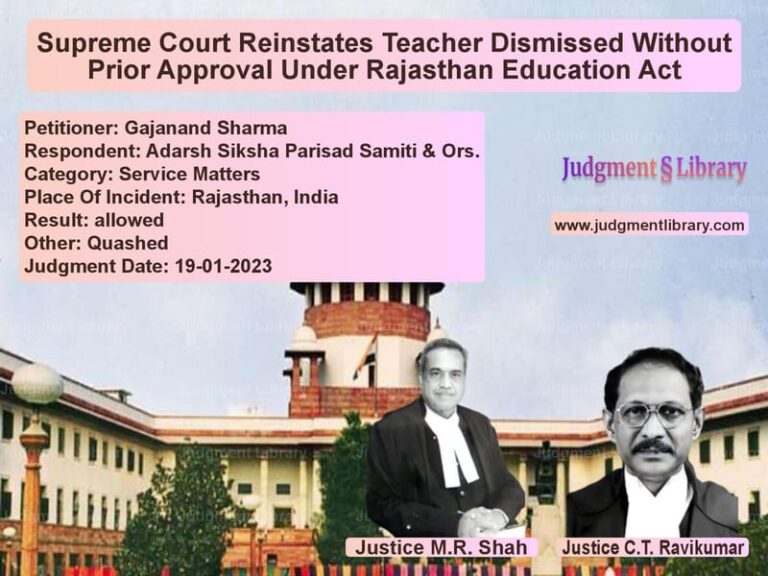Land Ceiling and Property Rights: Supreme Court Dismisses Appeal Against Land Vesting in Uttar Pradesh
The case of Sheetla Devi & Anr. v. State of Uttar Pradesh concerns a long-standing land dispute under the U.P. Imposition of Ceiling of Land Holdings Act, 1960. The Supreme Court, in its judgment dated March 12, 2019, reaffirmed the principle that once land is vested with the State under land ceiling laws, legal proceedings to reclaim such land must have a strong basis. The judgment dismissed the appellants’ attempt to revive ceiling proceedings related to excess land vested in the State since 1981.
The case highlights the judicial reluctance to entertain prolonged and repeated litigation in land ceiling matters and serves as an important precedent for land disputes governed by ceiling laws.
Case Background
The case pertains to land originally owned by Ram Bharose Lal. Proceedings under the U.P. Imposition of Ceiling of Land Holdings Act, 1960 began on January 30, 1974, when a notice under Section 10(2) of the Act was issued to determine the landholding status.
The case underwent multiple rounds of litigation before the Prescribed Authority, the Appellate Authority, and the Allahabad High Court. On September 30, 1974, the Prescribed Authority declared 5.08 acres of land as surplus. After a series of legal challenges, a revised decision by the Prescribed Authority on April 14, 1981, declared 2.90 acres of land as surplus and vested it with the State.
After the death of Ram Bharose Lal, his legal heirs, Sheetla Devi and her son, continued to challenge the proceedings and filed multiple applications to restore the case. Their writ petition challenging the land vesting was dismissed by the Allahabad High Court on January 5, 2008. The appellants then approached the Supreme Court.
Petitioner’s Arguments
The appellants, represented by Advocate Anurag Dubey, contended that:
- The Appellate Authority failed to comply with an earlier High Court order.
- The appeal before the Appellate Authority was filed by an imposter in their name, and no proper inquiry was conducted.
- The legal effect of the appellate order’s merger was not examined correctly.
Respondent’s Arguments
The State of Uttar Pradesh, represented by Advocate Tanmaya Agarwal, argued:
- The land had been lawfully declared surplus and vested with the State since 1981, and there was no basis for reopening the matter.
- The appellants’ attempts to revive ceiling proceedings were legally unfounded.
- The claim regarding an imposter filing the appeal was baseless and meant to prolong the litigation.
Supreme Court’s Observations and Ruling
The Supreme Court dismissed the appeal, holding that:
“The litigation, out of which this appeal arises, is pursued by the appellants only with a view to keep the issue relating to vesting of the land in question alive, which stood vested in the State in the year 1981 itself.”
The Court reaffirmed that once land is vested in the State, there is no legal ground to challenge the process unless there are substantial legal flaws:
“Indeed, in our view, the excess land measuring 2.90 acres is no more available, having stood vested with the State in 1981.”
The Court dismissed the appellant’s argument regarding the imposter claim:
“The question as to whether the appeal before the Appellate Authority was filed by some imposter, as alleged by the appellants, was wholly misconceived and was rightly not entertained.”
It also rejected the argument concerning the compliance of earlier High Court orders:
“The High Court rightly repelled these arguments and dismissed the writ petition.”
Finally, the Supreme Court reiterated that prolonged litigation without legal grounds only burdens the judicial system:
“The appellants have been attempting to revive the ceiling proceedings through multiple applications. This kind of litigation does not serve the cause of justice.”
Conclusion
The Supreme Court’s judgment in this case reaffirms several key legal principles:
- Once land is vested in the State under land ceiling laws, such vesting is final unless there is a substantial legal violation.
- Repeated litigation and attempts to reopen settled cases will not be entertained.
- The burden lies on the appellant to prove substantial legal errors, and procedural objections cannot be used to delay land ceiling enforcement.
By dismissing the appeal, the Supreme Court reinforced the State’s authority in land ceiling matters and ensured that legally vested land remains protected from unnecessary disputes.
Petitioner Name: Sheetla Devi & Anr..Respondent Name: State of Uttar Pradesh.Judgment By: Justice Abhay Manohar Sapre, Justice Dinesh Maheshwari.Place Of Incident: Uttar Pradesh.Judgment Date: 12-03-2019.
Don’t miss out on the full details! Download the complete judgment in PDF format below and gain valuable insights instantly!
Download Judgment: Sheetla Devi & Anr. vs State of Uttar Prade Supreme Court of India Judgment Dated 12-03-2019.pdf
Direct Downlaod Judgment: Direct downlaod this Judgment
See all petitions in Property Disputes
See all petitions in Landlord-Tenant Disputes
See all petitions in Succession and Wills
See all petitions in Judgment by Abhay Manohar Sapre
See all petitions in Judgment by Dinesh Maheshwari
See all petitions in dismissed
See all petitions in supreme court of India judgments March 2019
See all petitions in 2019 judgments
See all posts in Civil Cases Category
See all allowed petitions in Civil Cases Category
See all Dismissed petitions in Civil Cases Category
See all partially allowed petitions in Civil Cases Category







